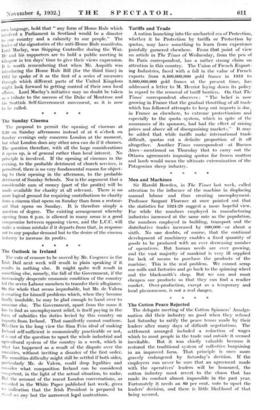Men and Machines Sir Harold Bowden, in The Times last
week, called attention to the influence of the machine in displacing manual labour and thus creating unemployment. Professor Sargant Florence at once pointed out that the statistics for 1924-29 suggest a more hopeful view. For while the numbers employed in manufacturing industries increased at the same rate as the population, the numbers employed in building, transport and the distributive trades increased by 600,000—or about a sixth. No one doubts, of course, that the continual development of machinery enables a fixed quantity of goods to be produced with an ever decreasing number of operatives. But human needs are ever growing, and the vast majority of mankind is very ill supplied for lack of means to purchase the products of the machine. This is the real problem. We cannot scrap our mills and factories and go back to the spinning wheel and the blacksmith's shop. But we can and must cheapen our products so that they can find a readier market. Over-production, except as a temporary and local phenomenon, is not a real danger.










































 Previous page
Previous page